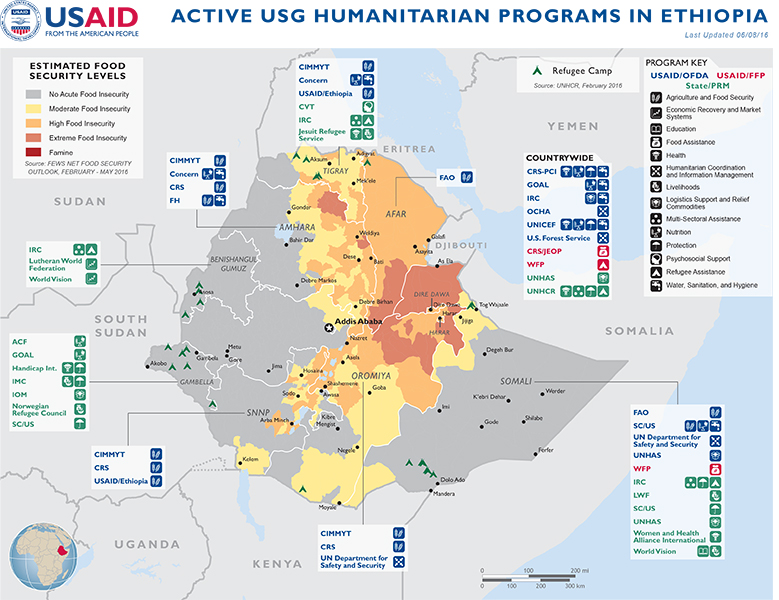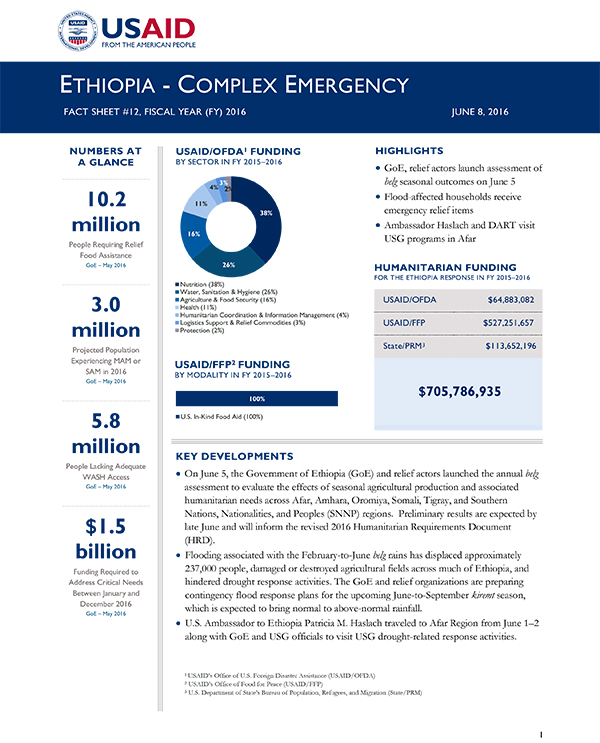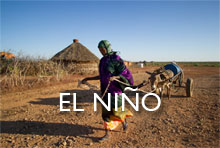- What We Do
- Agriculture and Food Security
- Democracy, Human Rights and Governance
- Economic Growth and Trade
- Education
- Ending Extreme Poverty
- Environment and Global Climate Change
- Gender Equality and Women's Empowerment
- Global Health
- Water and Sanitation
- Working in Crises and Conflict
- Disaster Assistance
- Political Transition Initiatives
- Conflict Mitigation and Prevention
- Countering Violent Extremism
- Disaster Risk Reduction
- Peacebuilding and Reconciliation
- Providing Safe & Secure Environments for Development
- Recovering From Crisis
- Resilience
- Tech Challenge for Atrocity Prevention
- World Humanitarian Day
- U.S. Global Development Lab
June 8, 2016
Highlights
GoE, relief actors launch assessment of belg seasonal outcomes on June 5
Flood-affected households receive emergency relief items
Ambassador Haslach and DART visit USG programs in Afar
Key Developments
Ethiopia Map - 06-08-2016 ![]() (pdf - 729k)
(pdf - 729k)
Numbers At A Glance
10.2 million
3.0 million
5.8 million
$1.5 billion
Humanitarian Funding
For the Ethiopia Response
FY 2015 - 2016
| USAID/OFDA | $64,883,082 |
| USAID/FFP | $527,251,657 |
| State/PRM | $113,652,196 |
| TOTAL | $705,786,935 |
On June 5, the Government of Ethiopia (GoE) and relief actors launched the annual belg assessment to evaluate the effects of seasonal agricultural production and associated humanitarian needs across Afar, Amhara, Oromiya, Somali, Tigray, and Southern Nations, Nationalities, and Peoples (SNNP) regions. Preliminary results are expected by late June and will inform the revised 2016 Humanitarian Requirements Document (HRD).
Flooding associated with the February-to-June belg rains has displaced approximately 237,000 people, damaged or destroyed agricultural fields across much of Ethiopia, and hindered drought response activities. The GoE and relief organizations are preparing contingency flood response plans for the upcoming June-to-September kiremt season, which is expected to bring normal to above-normal rainfall.
U.S. Ambassador to Ethiopia Patricia M. Haslach traveled to Afar Region from June 1–2 along with GoE and USG officials to visit USG drought-related response activities.
CURRENT EVENTS
Heavy belg rainfall and associated flooding—particularly in late March through early May—displaced approximately 237,000 individuals; resulted in at least 100 deaths; washed away livestock; and damaged or destroyed a substantial amount of agricultural cropland in Afar, Amhara, Oromiya, SNNP, Somali, and Tigray, according to the National Flood Task Force. Emergency relief commodities are a priority need among the displaced population, according to the International Organization for Migration (IOM). The GoE National Disaster Risk Management Commission (NDRMC) and IOM are coordinating the transport of relief supplies to flood-affected communities. Additionally, the UK Department for International Development (DFID) has airlifted approximately 30,000 emergency relief item kits to the GoE for distribution to affected households.
Flooding has also hindered ongoing drought response activities and damaged civilian and transport infrastructure, including bridges, dams, and roads. Following a similar exercise to address belg-related flood impacts, the NDRMC and relief organizations are preparing a contingency flood response plan for the kiremt season, during which average to above-average rainfall and potential flooding is expected across much of Ethiopia. As part of the contingency planning effort, the NDRMC has notified all regional governments to engage in risk mitigation measures, such as relocating households from areas typically affected by flooding and mudslides, and is preparing community awareness messages regarding the kiremt forecast and related meher planting activities.
The NDRMC, other GoE representatives, USAID staff, and relief actors launched the belg assessment on June 5; the assessment aims to evaluate effects of the belg rains across several sectors and resultant humanitarian needs in Afar, Amhara, Oromiya, SNNP, Somali, and Tigray. Approximately 19 teams, comprising experts from eight humanitarian sectors, will deploy throughout the affected areas in the coming days, with 15-day assessments planned for the largely agro-pastoral regions of Amhara, Oromiya, SNNP, and Tigray and 21-day assessments planned for the pastoral regions of Afar and Somali. The belg assessment will inform the revised 2016 HRD, which the GoE expects to release in July.
FOOD SECURITY
The GoE and relief actors—including the UN World Food Program (WFP) and the USAID-supported, Catholic Relief Services (CRS)-led Joint Emergency Operation (JEOP)—completed the second round of 2016 relief food distributions in late May. As of May 24, the GoE and relief actors had dispatched approximately 81 percent and distributed 37 percent of the third round of 2016 relief food assistance. According to WFP, the GoE and relief organizations dispatched an estimated 6 percent and distributed 1 percent of the fourth round of relief food assistance, which began in early May; the fifth round is scheduled to commence during the week of June 6, and the sixth round is expected to launch in July. Each round consists of approximately 170,000 metric tons (MT) of cereals, pulses, and cooking oil. Multiple rounds of relief food assistance continue simultaneously due to persistent logistics bottlenecks, including a lack of staff at regional GoE distribution hubs, which have resulted in delays at final distribution points. In recent weeks, the Logistics Cluster—the coordinating body for humanitarian logistics activities, comprising UN agencies, non-governmental organizations (NGOs), and other stakeholders—has worked to improve dispatch and distribution mechanisms and reduce operational bottlenecks, such as limited staff and warehouse storage.
Food consumption among relief food assistance beneficiaries has improved in recent months, according to the WFP Household Food Security Monitoring survey of more than 1,100 households in Afar, Amhara, Oromiya, SNNP, Somali, and Tigray. The results of the survey—conducted in March and April—indicate that inadequate food consumption responses have declined by 31 percent since February; however, an estimated 80 percent of surveyed households are unable to fulfill minimum daily food needs without relief assistance. Survey results also indicate consistently high reliance on negative coping strategies—including reducing meal size, skipping meals, and consuming less preferred and less expensive food items—and poor dietary diversity among respondents.
LOGISTICS
The Logistics Cluster, led by WFP, is working to improve GoE logistics capacity at warehouses and final distribution points. To expand NDRMC and JEOP food commodity storage capacity, the cluster began deploying 120 mobile storage units in May, according to WFP. Additionally, the cluster is supporting recruitment and onboarding of new staff to strengthen commodity inventory and reporting systems in Ethiopia’s key warehouses, while bolstering NDRMC efforts to monitor the humanitarian supply chain from the Port of Djibouti to improve transparency of food commodity transport and coordination for humanitarian partners.
AGRICULTURE
From May 25–31, USAID Disaster Assistance Response Team (DART) staff visited several areas of Oromiya and SNNP, where USAID partner the International Maize and Wheat Improvement Center (CIMMYT) and the GoE Agriculture Transformation Agency (ATA) have distributed high-quality, drought-tolerant maize and rust-resistant wheat seeds to farming households. Launched in March, the CIMMYT emergency seed intervention is expected to reach approximately 226,000 smallholder farming households—nearly 1.4 million people—in 67 drought-affected woredas, or districts, of Amhara, Oromiya, SNNP, and Tigray.
During the farm visits and meetings with beneficiary farmers, the DART observed strong coordination by several relief organizations conducting interventions at the regional and zonal levels to avoid duplication of seed distribution efforts. Several varieties of planted maize seeds appeared to have germinated well, except in flood-affected districts, such as SNNP’s Halaba District and Oromiya’s Siraro District, where rainfall inundated maize fields and farmers must replant seeds. Additionally, some beneficiaries reported that obtaining necessary fertilizer was difficult due to limited financial resources or accumulated loans from micro-finance organizations.
As of mid-May, relief organizations in Tigray had only secured an estimated 3,450 of the 9,800 MT—approximately 35 percent—of seeds required to support nearly 347,000 seed-insecure households in the region. To help fill the emergency seed response gap in the region, USAID/FFP recently authorized partner Relief Society of Tigray (REST) to pivot approximately $738,000 in existing development resources to deliver seeds to an estimated 14,750 farmers through the USAID-funded, GoE-led Productive Safety Net Program (PSNP). USAID/FFP supports the PSNP with an annual contribution of approximately $100 million to four NGO partners to implement development food assistance programs with chronically food-insecure communities; the PSNP traditionally includes a small seed component.
HEALTH, NUTRITION, AND WASH
Heavy rainfall in recent months has increased the risk of waterborne disease transmission in affected areas, as households are consuming water from unprotected sources such as ponds and surface wells, according to the UN. As of late May, health actors had identified acute watery diarrhea (AWD) cases in 11 districts of Oromiya and Somali regions within the past 30 days; the UN World Health Organization (WHO) reports more than 1,930 cases of AWD and 19 related deaths across an estimated 26 districts in Oromiya, SNNP, and Somali between January and June 3. Two additional AWD cases were recently confirmed in previously unaffected districts of Harena in Oromiya and Dolobay in Somali, which is located along Ethiopia’s southern border with Kenya. Health personnel in SNNP have not reported any new AWD cases in the region for six consecutive weeks.
Despite access constraints, including flood-affected roads, the UN agency and other health organizations are supplementing the GoE Ministry of Health response to contain the AWD outbreak through several interventions. These include the deployment of health, surveillance, and other technical staff to Oromiya and Somali; rehabilitation of water sources; distribution of 283,000 sachets of household water treatment chemicals to targeted communities; social mobilization efforts for affected communities; and AWD and water, sanitation, and hygiene (WASH) response trainings for health workers.
Overall coordination of nutrition activities is improving, with the GoE Emergency Nutrition Coordination Unit (ENCU) working to streamline organizational responsibility and timelines for the implementation of nutrition interventions at the district level. Additionally, ENCU, WFP, and the UN Children’s Fund (UNICEF) have placed nutrition monitors at the regional level to improve information sharing—particularly regarding priority one hotspot districts. Hotspot districts are classified as the most in need of humanitarian assistance based on the impact of food availability, WASH infrastructure, access to markets, the nutrition situation, and other contributing factors.
From June 1–2, Ambassador Haslach, GoE Minister of Culture and Tourism Aisha Mohammed, and members of the DART traveled to Afar Region to visit USG drought-related response activities, including a USAID-supported International Rescue Committee (IRC) water rehabilitation project in Mile District. The delegation observed rehabilitation of a water system serving approximately 1,500 people in Mile, including a shallow borehole that IRC recently rehabilitated to pump water near a local health facility, as well as to a dedicated livestock trough.
CONTEXT
Multiple consecutive seasons of below-normal rainfall and the current effects of the El Niño climatic event have resulted in deteriorating agricultural, livestock, food security, and nutrition conditions in northeastern and central Ethiopia. By December 2015, the GoE estimated that 10.2 million people required relief food assistance and other humanitarian interventions during 2016.
USAID activated a Disaster Assistance Response Team (DART) on February 24, 2016, to lead the USG crisis response to the drought in Ethiopia. In support of the GoE, the DART is coordinating USG response activities in close partnership with the UN and other relief organizations. The DART—composed of humanitarian specialists based in Ethiopia—is addressing critical needs and examining ways to realign activities to respond to urgent assistance gaps. USAID also established an Ethiopia Drought Response Management Team (RMT) based in Washington, D.C., to support emergency response efforts in Ethiopia.
While drought remains a major contributor to vulnerability in Ethiopia, negatively affecting the lives and livelihoods of farmers and pastoralists, populations also continue to confront other challenges—including seasonal flooding, localized intercommunal conflict, above-average food prices, disease outbreaks, and limited access to health and WASH services—that contribute to sustained humanitarian needs and an ongoing complex emergency in Ethiopia.
On October 7, 2015, U.S. Chargé d’Affaires, a.i., Peter H. Vrooman re-declared a disaster for Ethiopia in response to the ongoing complex emergency.
PUBLIC DONATION INFORMATION
The most effective way people can assist relief efforts is by making cash contributions to humanitarian organizations that are conducting relief operations. A list of humanitarian organizations that are accepting cash donations for disaster responses around the world can be found at www.interaction.org.
USAID encourages cash donations because they allow aid professionals to procure the exact items needed (often in the affected region); reduce the burden on scarce resources (such as transportation routes, staff time, and warehouse space); can be transferred very quickly and without transportation costs; support the economy of the disaster-stricken region; and ensure culturally, dietary, and environmentally appropriate assistance.
More information can be found at:
- USAID Center for International Disaster Information: www.cidi.org or +1.202.821.1999.
- Information on relief activities of the humanitarian community can be found at www.reliefweb.int.










Comment
Make a general inquiry or suggest an improvement.